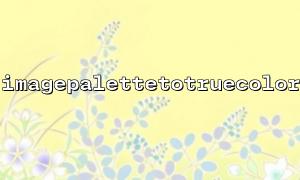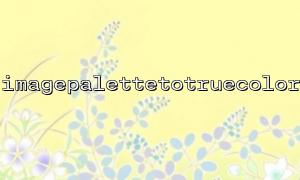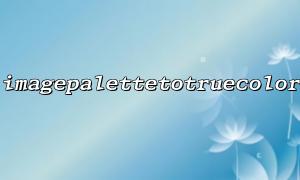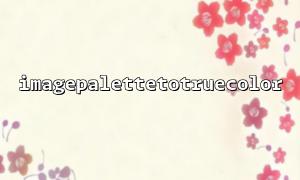In PHP, the imagepalettetotruecolor function is used to convert a palette-based image into a true color image. Palette-based images typically use color indexing, which is suitable for images with fewer colors, while true color images use the RGB model to represent each pixel. Although this function aims to improve the quality and color representation of images, color distortion issues may occur in practice. This article will analyze the root causes of this issue and explore effective solutions.
In PHP, the imagepalettetotruecolor function can convert a palette-based image into a true color image. The basic syntax of the function is as follows:
<span><span><span class="hljs-keyword">bool</span></span><span> </span><span><span class="hljs-title function_ invoke__">imagepalettetotruecolor</span></span><span> ( resource </span><span><span class="hljs-variable">$image</span></span><span> )
</span></span>$image is a GD image resource, typically created using functions such as imagecreatefrompng(), imagecreatefromgif(), or imagecreatefromjpeg().
The function returns a boolean value indicating whether the conversion was successful.
The converted image can represent each pixel with a 24-bit color depth, meaning each color channel (red, green, blue) has 8 bits, which typically provides richer color representation.
Although the purpose of imagepalettetotruecolor is to enhance the color representation of images, in some cases, the converted image may suffer from color distortion, making the image appear unnatural. This distortion is often manifested as color shifts, faded colors, or reduced contrast.
The causes of this distortion can vary, with some common reasons outlined below:
Palette images and true color images use different color models. Palette images typically use an indexed color model, where each pixel stores an index value pointing to a color in the color table, rather than storing the color value directly. This means that during conversion, some color precision may be lost, especially when the color table contains fewer colors.
Palette images usually have an 8-bit color depth (i.e., up to 256 colors), while true color images use a 24-bit color depth (i.e., 8 bits for each color channel, totaling 16,777,216 colors). During conversion, if the original image's palette is not rich enough, some colors may not be accurately mapped to the true color image, resulting in color distortion.
When converting a palette image to a true color image, PHP may perform a reverse color mapping. Since the palette's color set is small and the target true color image has a larger color gamut, this reverse mapping may cause some colors to shift or be lost. This distortion may be more noticeable when the original image's colors lean toward specific tones (such as bright red or green).
Some palette-based images (such as GIF or PNG) may contain transparency information, which needs special handling when converting to a true color image. If the transparency conversion method is inappropriate, it may result in image distortion or unwanted edge effects.
To address the issues mentioned above, the following methods can be used to reduce or avoid image color distortion:
Before conversion, ensure that the palette-based image's color table contains enough colors. For simpler images, consider using a palette with more colors (e.g., using 16-bit or higher color depth). This can be done by adjusting the parameters of the image creation function and using a larger color table to avoid issues with insufficient color precision.
If color distortion occurs, consider using more precise color conversion algorithms. For example, when mapping color indexes to RGB, use more sophisticated algorithms to avoid color shifts caused by the simplest linear mapping. Custom functions or external libraries can be used to implement color optimization.
After conversion, if the image exhibits color distortion, try adjusting the contrast and saturation to make the colors appear more natural. PHP's GD library provides some functions, such as imagefilter(), which can be used to filter and adjust the image. For example, imagefilter($image, IMG_FILTER_CONTRAST, -10) can be used to adjust the contrast.
If the original image contains transparency information (such as in PNG or GIF formats), make sure the transparency is properly handled during conversion. You can use imagealphablending() and imagesavealpha() to preserve transparency and handle the alpha channel. This can effectively prevent edge blurring or unwanted opacity after conversion.
<span><span><span class="hljs-title function_ invoke__">imagealphablending</span></span><span>(</span><span><span class="hljs-variable">$image</span></span><span>, </span><span><span class="hljs-literal">true</span></span><span>);
</span><span><span class="hljs-title function_ invoke__">imagesavealpha</span></span><span>(</span><span><span class="hljs-variable">$image</span></span><span>, </span><span><span class="hljs-literal">true</span></span><span>);
</span></span>If the above methods do not completely resolve the issue, consider using higher-quality image formats. For example, avoid using simpler formats like PNG8 or GIF and switch to formats such as PNG24 or JPEG, which support higher color depth and compression efficiency.
imagepalettetotruecolor is a very useful image processing function in PHP that can convert palette-based images to true color images, enhancing the color representation. However, due to the differences in color representation between palette and true color images, color distortion may occur during the conversion process. By adjusting the image's palette, using more precise conversion algorithms, tweaking the contrast and saturation of the image, or properly handling transparency, these color distortion phenomena can be significantly reduced or avoided. These methods allow us to achieve better image quality when using the imagepalettetotruecolor function.



